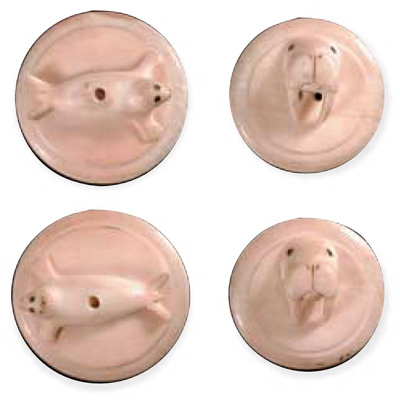
Hunting or fishing gear? Amulets or charms? Gaming pieces? These walrus ivory objects, delicately carved bas-reliefs with images of either a seal or a walrus head, fall squarely within the long carving tradition found among the Inupiaq-speaking Bering Strait Eskimo of northern Alaska. The ivory objects are, in fact, buttons. We have 14 of these buttons in our collection. Nine are carved with the figure of a seal splayed out as if sunning itself, and five with the image of a full-front walrus head. The details rendered in these pieces (the fatness of the seal, the curve of the walrus tusks as they emerge from the head, the fine delineation of the facial features of the animals by engraved lines filled with black pigment) point to an Eskimo artist who was not only a keen observer of his own world but also an accomplished carver who could make that world tangible to an outsider.
Eskimo art was primarily religious and ceremonial. The carving of amulets and charms out of walrus ivory and wood into naturalistic figurines, in both human and animal form, has a long history in the archaeological record of Alaska, found in sites from almost all periods. This tradition of carving naturalistic figures to be hung on boats and in dwellings, and fastened to hunting and fishing gear, boxes, and many other objects persisted throughout the centuries. In the mid-19th century, however, it began to serve another purpose, that of creating souvenir art.
Our 14 ivory buttons — there were originally 20, but six were exchanged to another museum — were obtained from the King Island Eskimo in 1899 by Patrick Henry Ray, a First Lieutenant in the Signal Corps of the 8th U.S. Infantry. Ray led the International Polar Expedition to Point Barrow, Alaska, from 1881–1883, to carry out various meteorological and other scientific observations. In 1908, George Byron Gordon, who joined the University of Pennsylvania Museum in 1904 as assistant curator and became director in 1910, purchased Ray’s collection. In addition to 27 Eskimo pieces (some of which were collected on the expedition to Point Barrow in 1881), Ray’s collection included Native American objects from the Plains, the Southwest, and California. The Museum then purchased Gordon’s collection in 1915.
William Wierzbowski is assistant keeper in the American Section.
